

Free Google Slides or PowerPoint School Planner 2020-2021. Free Google Slides or PowerPoint School Planner 2020-2021 with hyperlinks. Katie Digital Planner was thought more as tutorial than a template, but since it was such a hit among educators, we decided to add a new one, especially for teachers and students, this time based on the school calendar for the north hemisphere. We chose blue, but as you can see on the screen shots, it’s completely customizable, you can change colors, and even the tab names by editing the master.
The cover is made of digital cardboard paper, but if you want to change its color: go to 1. Select image. 2. Select Format Options. 3. To change the colors go to Slide > Edit Master and change the theme Colors. Remember that you can use it directly on Google Slides or PowerPoint or you can delete the instructions and dummy text, download it as PDF and use it in you iPad or any other device with a stylus. Like Katie, it has hyperlinks to navigate from tab to tab. School Planner August 2020 – July 2021. Resources for Learning about Educational Technology. I read a quote today that made me think about my summer professional development.
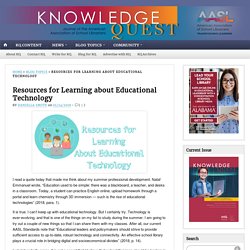
Nataf Emmanuel wrote, “Education used to be simple: there was a blackboard, a teacher, and desks in a classroom. Today, a student can practice English online, upload homework through a portal and learn chemistry through 3D immersion — such is the rise of educational technologies” (2018, para. 1). It is true. I can’t keep up with educational technology. But I certainly try. I wholeheartedly agree. What Is Successful Technology Integration? Teaching Science with Technology: Case Studies of Science Teachers’Development of Technology, Pedagogy, and Content Knowledge – CITE Journal. Science teaching is such a complex, dynamic profession that it is difficult for a teacher to stay up-to-date.
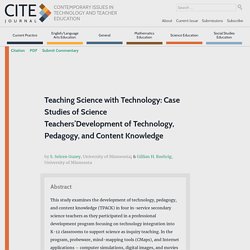
For a teacher to grow professionally and become better as a teacher of science, a special, continuous effort is required (Showalter, 1984, p. 21). To better prepare students for the science and technology of the 21st century, the current science education reforms ask science teachers to integrate technology and inquiry-based teaching into their instruction (American Association for the Advancement of Science, 1993; National Research Council [NRC], 1996, 2000). The National Science Education Standards (NSES) define inquiry as “the diverse ways in which scientists study the natural world and propose explanations based on the evidence derived from their work” (NRC, 1996, p. 23).
Teaching science as emphasized in the reform documents, however, is not easy. Review of the Relevant Literature. Effective Technology Use in Math Class. Incorporating technology in mathematics classrooms enables educators to craft powerful collaborative learning experiences that support problem solving and flexible thinking.
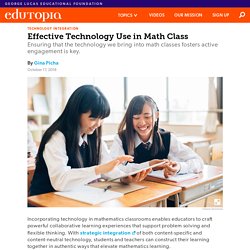
With strategic integration of both content-specific and content-neutral technology, students and teachers can construct their learning together in authentic ways that elevate mathematics learning. Until recently, one of educators’ primary concerns around educational technology was the lack of access that existed in many American schools.
That gap has decreased, but a new digital divide has emerged: The updated 2017 National Education Technology Plan explains that in today’s classrooms many students are using technology as a tool for passive learning rather than engaging in active learning experiences that promote student agency. The Importance of Content-Specific Pedagogy. How to use technology for learning. Are games a waste of time?
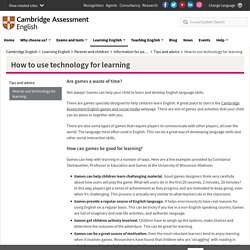
Not always! Games can help your child to learn and develop English language skills. There are games specially designed to help children learn English. A great place to start is the Cambridge Assessment English games and social media webpage. There are lots of games and activities that your child can do alone or together with you. There are also some types of games that require players to communicate with other players, all over the world. How students can use technology to improve their English. It’s no secret that technology has become more central in our everyday lives than ever before.
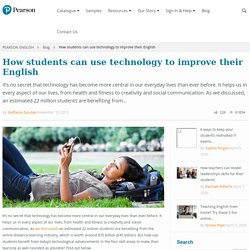
It helps us in every aspect of our lives, from health and fitness to creativity and social communication. As we discussed, an estimated 22 million students are benefiting from the online distance learning industry, which is worth around $70 billion (£45 billion). But how can students benefit from today’s technological advancements in the four skill areas to make their learning as well rounded as possible? Find out below. Reading With the rise of iPads, tablets and e-readers like the Kindle, we’ve come accustomed to a more interactive reading experience, which is a wonderful feature for English learners.
Writing. Using Tech for ELA Differentiation and Assessment. When I taught high school English Language Arts (ELA), one of the ways I utilized technology was to engage my students in different types of reading and writing.
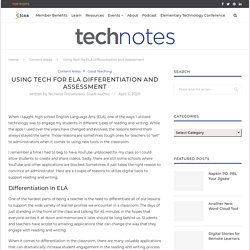
While the apps I used over the years have changed and evolved, the reasons behind them always stayed the same. Those reasons are sometimes tough ones for teachers to “sell” to administrators when it comes to using new tools in the classroom. I remember a time I had to beg to have YouTube unblocked for my class so I could allow students to create and share videos. Sadly, there are still some schools where YouTube and other applications are blocked. Sometimes it just takes the right reason to convince an administrator.
Differentiation in ELA One of the hardest parts of being a teacher is the need to differentiate all of our lessons to support the wide variety of learner profiles we encounter in a classroom. Differentiation Tools Variety of Assessment The PBL Puzzle. Teaching. Teaching Section 2: Teaching with Technology Goal: Educators will be supported by technology that connects them to people, data, content, resources, expertise, and learning experiences that can empower and inspire them to provide more effective teaching for all learners. Technology offers the opportunity for teachers to become more collaborative and extend learning beyond the classroom. Educators can create learning communities composed of students; fellow educators in schools, museums, libraries, and after-school programs; experts in various disciplines around the world; members of community organizations; and families.
All Educational Technology articles. Teaching & Learning Archives. It's NOT About Google, It's About the LEARNING (ISTE Empowered Learner) What Is Successful Technology Integration? Educational Technology Resources for Teachers (Grades K-12)